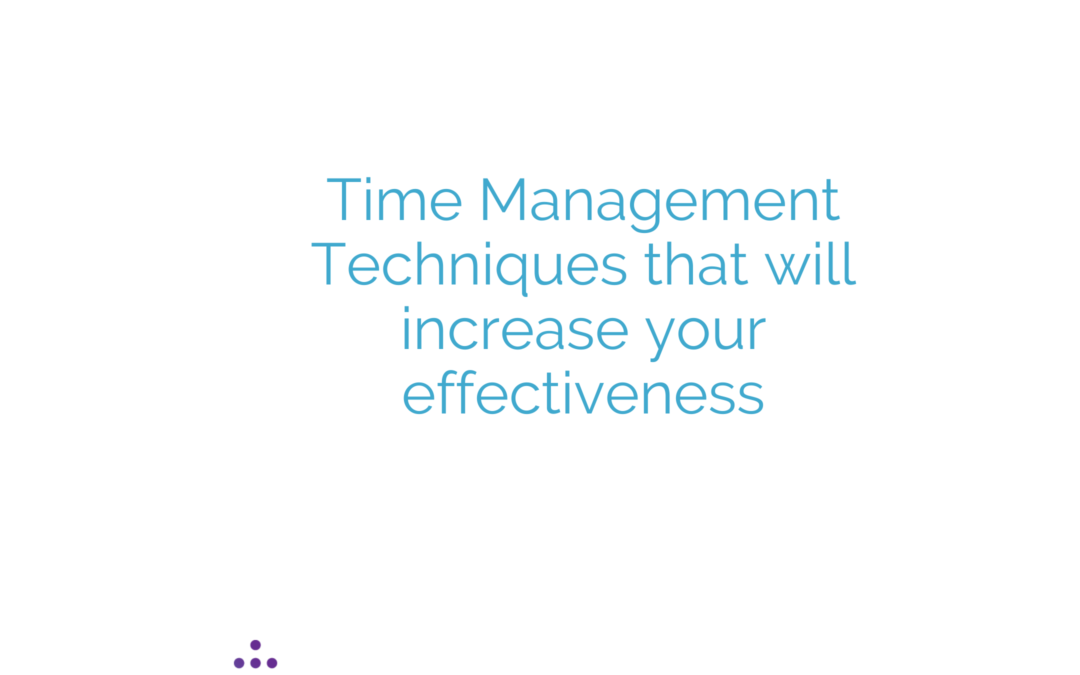
Time Management refers to managing time effectively so that the right time is allocated to the right activity. Managing your time well can help improve your career, improve efficiency and productivity, reduce stress and help you to achieve your professional goals.
Time Management Techniques are important because they help you structure your work in a way that allows you to accomplish goals. It is the process of planning and controlling how much time to spend on specific activities and to make the best use of time. For example, if your goal is to get a new job, you need time to complete tasks such as updating your CV, preparing for interviews and applying for jobs. Setting aside specific amounts of time will ensure you will complete these tasks.
Time Management Techniques that will increase your effectiveness:
- Eat That Frog Technique. This technique is named after a Mark Twain quote: “Eat a live frog first thing in the morning and nothing worse will happen to you the rest of the day”. Start your day by doing the most onerous tasks first and getting them out of the way. Your frogs each day are the tasks that will have the greatest impact on achieving your goals, which are usually the tasks that you’re most likely to procrastinate on.
How the Eat That Frog Technique works:
- Get clear on a goal. What do you want to achieve the most?
- Write it down.
- Set a deadline.
- Compile a list of things you need to do to achieve your goal.
- Organise this list in order of priority. The most important items are probably the most difficult. These are your “frogs”.
- Take action. If you have more than one frog on your plate, eat the nastiest one first.
- Repeat this cycle very day so that you’re always doing something that will push you toward your goal.
- Pickle Jar Theory. This theory helps you figure out what is useful and what is not useful in your daily life. It allows you to plan tasks with time to spare and set priorities for your day.
How the Pickle Jar Theory works:
Imagine a pickle jar full of sand, pebbles and rocks. The sand is at the bottom and the rocks sit at the top.
The sand: This represents disrupting elements of your day, such as phone calls, emails, social media.
The pebbles: This represents tasks that need to be completed but can be done on another day or by someone else.
The rocks: These are the most important tasks that need to get done today.
- Begin by thinking about how your tasks for the day would fit into the above categories.
- Then make a task list starting with the rocks and ending with sand.
- Include an honest time estimate next to each task.
- Try not to plan more than six hours of an eight-hour working day. This will leave buffer time for the pebbles and sand.
- Pomodoro Technique. The Pomodoro technique was created by entrepreneur and author Francesco Cirillo. This technique uses a timer to break down your work into intervals. Each interval is known as a Pomodoro, names after the tomato-shaped timer that Cirillo created.
How the Pomodoro Technique works:
- Choose a task you need to get done.
- Set a time (e.g. 25 minutes).
- Focus on the task at hand.
- When the timer rings, put a checkmark on a piece of paper.
- Take a short break: (3-5minutes). Do something non work related to give your brain a break – go for a short walk, grab a cup of coffee.
- Repeat steps 2-5. Once you have completed this process four times, you can begin to take longer breaks (20minutes).
4. Set Professional Goals using the SMART Goal Setting Technique. This is a clear and simple framework that reduces the risk of creating a vague or unclear goal that is unlikely to be achieved. SMART is an acronym for Specific, Measurable, Achievable, Relevant and Timely.
How to create a SMART Goal:
- Specific: Identify some specific reasons, purposes, or benefits of accomplishing the goal. A specific goal has a much greater chance of being accomplished than a general goal.
- Measurable: Establish the criteria for measuring progress towards your goal. If there are no criteria, you will not be able to determine your progress and if you are on track to reach your goal.
- Achievable: A SMART goal must be achievable and attainable. Set a challenging target that stretches your ability but keep it attainable so that it can remain possible.
- Realistic: A goal must represent an objective toward which you are both willing and able to work.
- Timely: A goal must be time-bound in that it has a start and finish date. If the goal is not time-constrained, there will be no sense of urgency and, therefore, less motivation to achieve the goal.
I hope you enjoyed reading this article and that you have gained some time management techniques that will increase your effectiveness. Please share this article with anyone who might benefit from it.
© Maria O'Dwyer Coaching. Unauthorised use and/or duplication of this material without express and written permission from this site’s author and/or owner is strictly prohibited. Excerpts and links may be used, provided that full and clear credit is given to Maria O'Dwyer Coaching with appropriate and specific direction to the original content.

